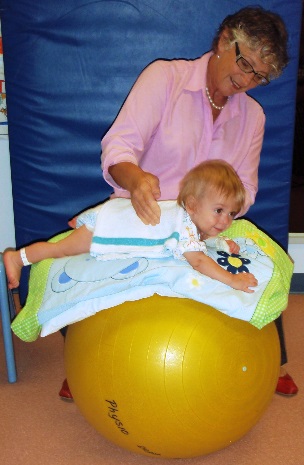Chest percussion and expiratory vibrations
What is the technique?
Percussion and vibrations are manual techniques that are applied to the chest wall.
Percussion is a passive technique that is performed on a child by another person. Percussion is a useful technique that helps to loosen the sputum in the lungs and may stimulate coughing. Percussion should never be painful
Vibration: uses a tremorous action over the area in which the hand is placed on the chest wall during expiration and is thought to increase expiratory flow rates as well as provide kinetic energy transmission into the lung tissue and cause changes in intrathoracic pressures. This technique can be a difficult technique for caregivers to learn for home management.
Prescription of the Percussion technique
Percussion must be applied safely with awareness of surface anatomy and lung tissue. When teaching parents it may be helpful to align the towel with the lowest safe location for percussion- which is several centimeters above the rib margins
Percussion is often performed using either one or two hands, using a cupped hand when the child’s chest wall surface area is safe for the whole hand (Fig. 1)
Modify frequency and force of percussion as required to ensure comfort of patient
Encourage patient where possible to perform deep breathing exercises
Ideally there should be pauses after 20-30 seconds of continuous percussion and vibrations applied intermittently


Fig. 1 Therapy ball used for positioning, percussion, vibration, and integrated acceleration activities.
Prescription of the Vibration technique
Vibrations should be timed with expiration and applied to ensure an increase in expiratory flow bias
In patients who are unable to perform deep breathing exercises independently, other techniques should be used to encourage increased tidal volumes (e.g. passive upper limb movement, manual hyperinflation, stretch facilitation on chest wall)
The physiotherapist will assist in an individual plan for the child, including the positions to be used, the amount of time performing percussion or vibrations in each position, number of sessions per day and any other additional physiotherapy techniques to be used whilst performing percussion e.g. huffing or ACBT
Benefits
If the child is unwell, too tired or is unable to actively participate (e.g. due to a disability) in active techniques
Precautions
Evidence for clinical application of Percussion and Vibration
Very few studies have evaluated the effects of percussion and vibration in modified postural drainage positions which is what is recommended for the majority of paediatric lung disease populations
It is unclear the exact mechanisms in which percussion and vibration may aid secretions clearance. It has been hypothesised that the transfer of kinetic energy can cause changes in sputum rheology by thinning them (van der Schans et al., 1999). It is also thought that the changes in intrathoracic pressure aid the movement of secretions in a cephlad direction from the peripheral airways into the trachea from which the secretions can then be coughed and expectorated (van der Schans et al., 1999)
Both of these techniques are thought to improve the mobilisation of bronchial secretions, attempt to match the ventilation and perfusion as well as normalise functional residual capacity (Cross et al., 2010). A majority of studies combine percussion and vibration with postural drainage positions, huffing and coughing and often other airway clearance techniques such as ACBT or suction, which makes it very difficult to know which of the techniques is effective
There is insufficient evidence to support or refute the use of percussion and vibrations in the bronchiectasis population group (Jones & Rowe, 2000)








